I build a content calendar with 132 rows each month. Eighteen of those rows require a keyword, headline, brand and product, and reputable external sources. The remaining 114 require a keyword, headline, and external links; 44 of those 114 rows also require a brand and product and an internal link to a page relevant to the headline.
I work for an ecommerce company with more than 10,000 products, so you can see why there is such a large volume.
The content calendar takes around three days to build with interruptions during that time.
I then assign these tasks in Asana.
What My Process Looks Like
For privacy reasons, I’m not going to disclose too many specific details, but I will provide screenshots that offer some amount of insight into this process.
Following that, I will go into a bit of detail describing why we build the content calendar, its uses, and how the process can be both beneficial and flawed.
Choosing a Brand and Product
When building content ideas, I often need to consider brands and products we sell. These articles will support these brands and products internally and externally.
We already have a list of brands and products that are high volume, low keyword difficulty, and provides good margins, so there isn’t too much work that needs done at this stage. However, each quarter we review this list and add to it.
From this list, I chose the product Ultimate E Mixed Tocopherols from Thorne Research. For the article, I am going to find a keyword related in some way to this product.
I also know this will be an internal article that goes on the nhc.com domain.
As I mentioned in my article, Reflecting on SEO, these pages are meant to be read by Google as informational articles first, not product features. However, the search intent might also have buying intent.
With that in mind, we need to make sure the article is built in such a way that it might rank well organically, develop authority, and as a result the linked product and brand also increase in authority and ranking. This is the power of Internal Linking, a worthwhile skill that all writers should learn.

The headline I came up with is: “Is Vitamin E for Menopause Beneficial?”
Not a very colorful headline, but as a supplement provider, we must use discretion when it comes to the language we use.
For example, saying “Use Vitamin E for Hot Flashes” might fly elsewhere and get more clicks, but we must limit our risk of being targeted by the FDA or provide questionable information to a potential buyer of the product we are linking to.
I went ahead and revealed the title first, but how did I come up with it?
Keyword Research Phase
The keyword research phase beings in Ahrefs. I know I have a “vitamin E” product, so I start looking for keywords broadly and then narrow things down.
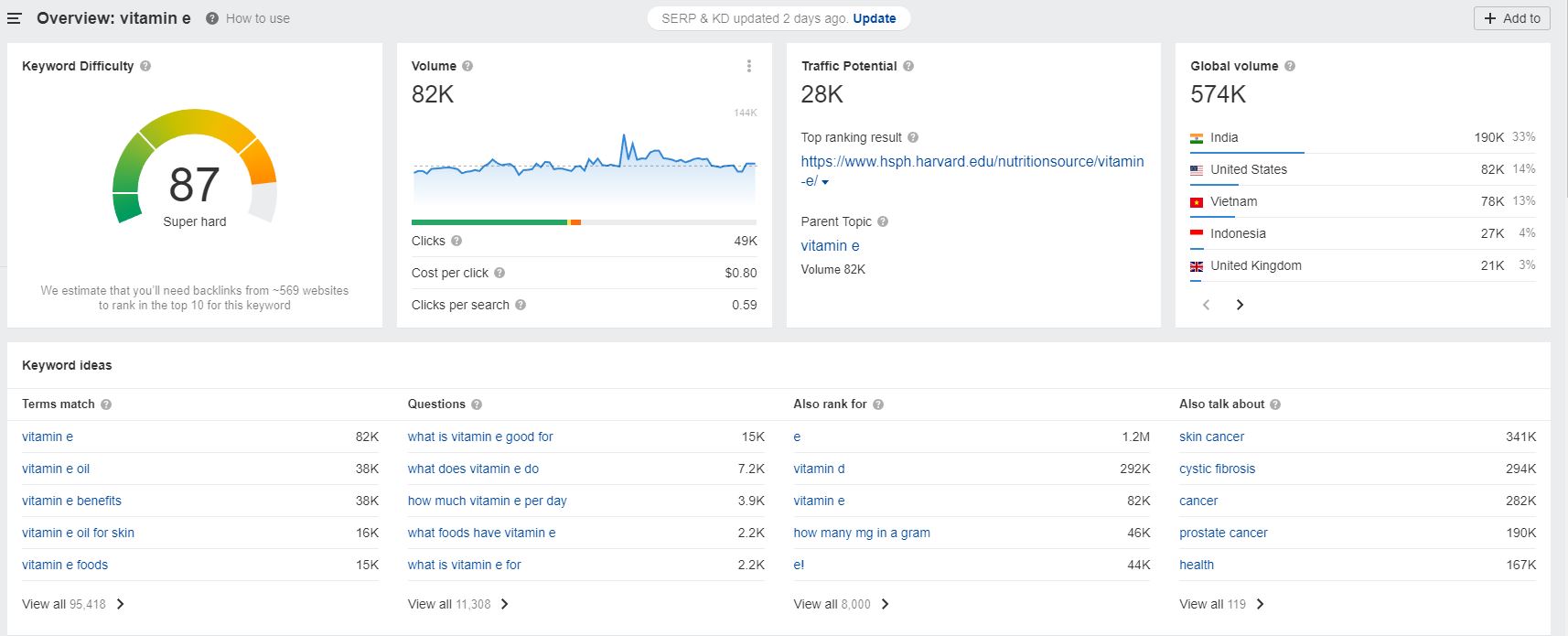
The volume for vitamin E is immense and the difficulty is almost impossible. If you don’t have a domain ranking in the 90s with thousands of backlinks and an incredible UX, you have almost zero shot of ranking.
Here’s proof of that.
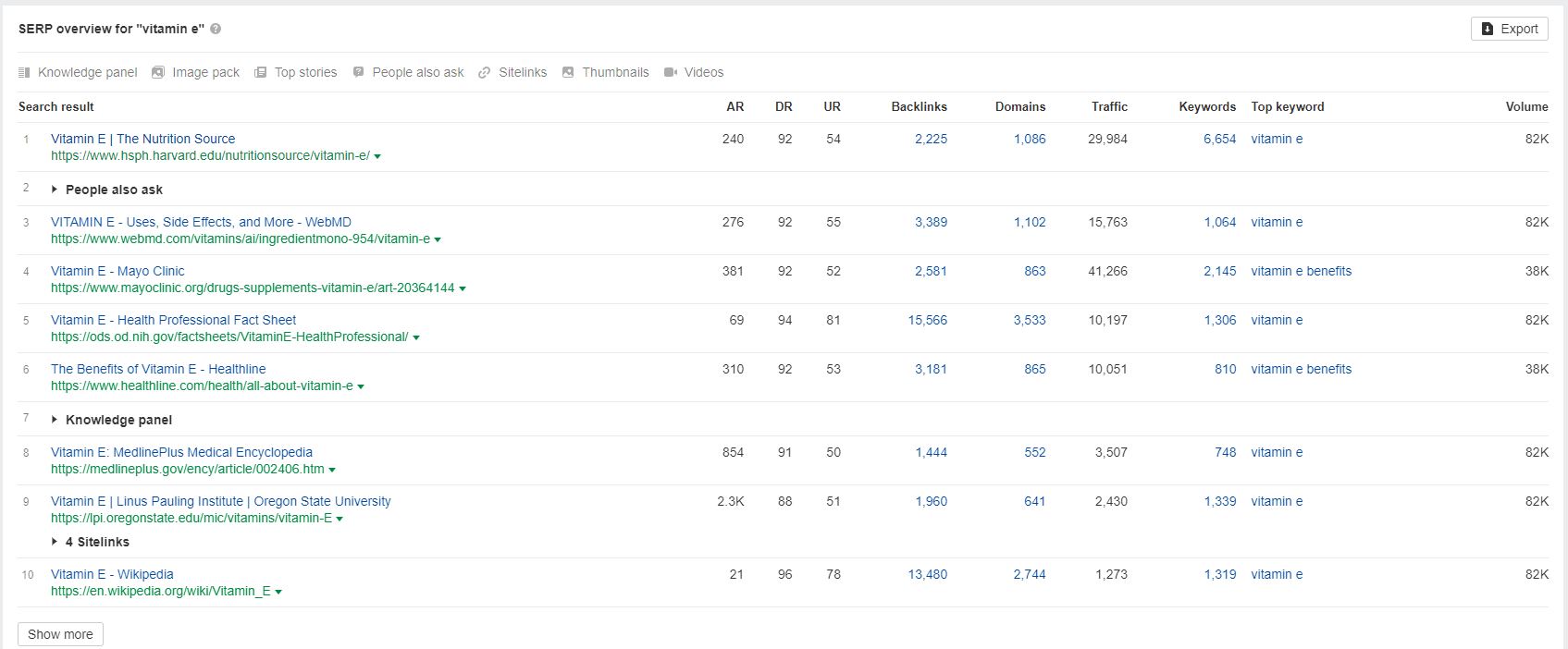
Look at those high quality domains owning the space for these big keyword terms.
Unfortunately, for Wikipedia, they don’t get much love anymore. Wikipedia is actually a great example of how Google is trying to steer domains towards a single purpose or intent. Not just that, but Wikipedia is supported by volunteers providing information. According to Google’s E-A-T guidelines, Google wants to see credible names and titles associated with articles.
Wikipedia has a lot of information about many topics. However, if I have a health question, wouldn’t I be better served by Harvard or Mayo Clinic? If I want to know on what day the French Revolution started, perhaps Wikipedia would be a good starting point – actually, Britannica wins this one. Take from that what you will.
Now we need to narrow down “vitamin E” to a keyword we have a shot at ranking with.
The best way to do this is to use “Site Explorer” and enter “Healthline.com.” The reason for this is Healthline has thousands of articles covering nearly every topic in the health and wellness space.
This approach quickens the creation of the content calendar because Healthline has likely already developed content around a set of keywords related vitamin E and doing the hard work for me. However, because it is a long-tail keyword, oftentimes the article is less popular with less investment into the content.
So if we write a more focused article around one of these less popular keywords, we might rank relatively well.

You can see I set the filters to a Keyword Difficulty (KD) of “30” and that it must contain the phrase “vitamin E.” I sometimes tweak the other filter options if I get too many results and want to narrow it down more.
Scanning the results, I have an interesting hit.
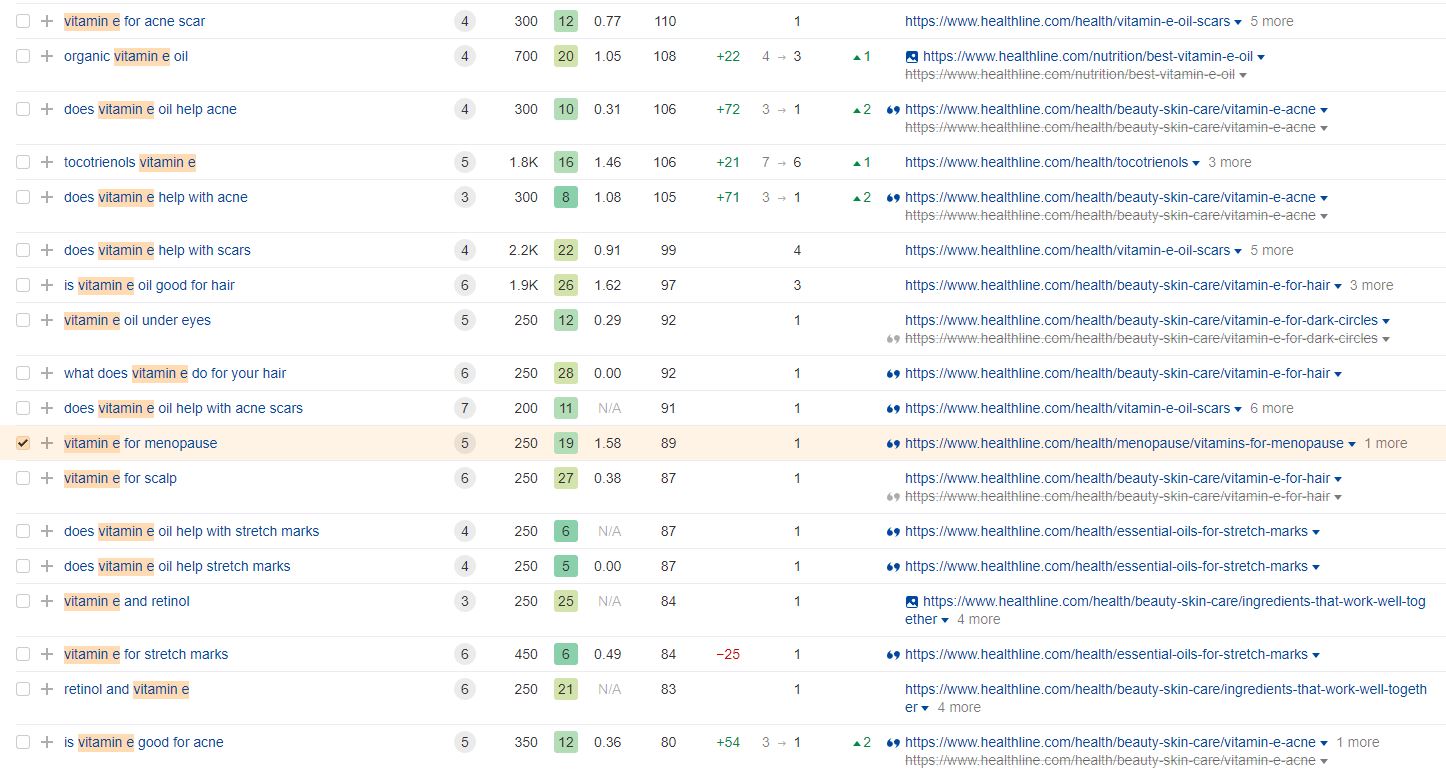
When looking at keyword options, I am looking for those that are focused and potentially actionable. Meaning that people are information gathering, but they may also be looking for a solution.
Vitamin E for menopause looks like a strong candidate.
Here is a closer look at “vitamin e for menopause.”

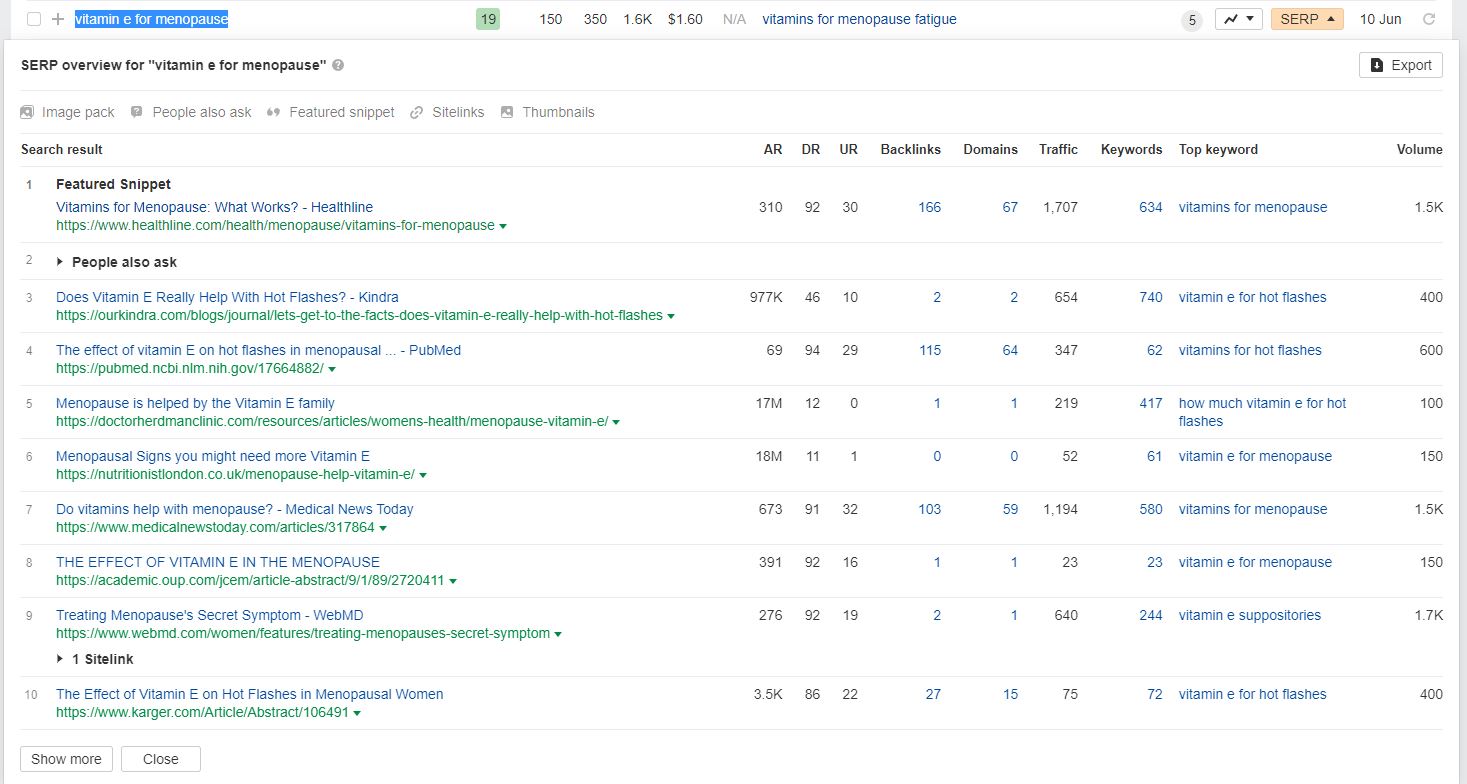
Healthline is number one, as expected, but there is a lot of domain variety competing in the top 10. What I often run into is Healthline, WebMD, Harvard, and NCBI research papers dominate the top 10, meaning that ranking will be difficult.
But if you look at the 5th and 6th results, these domains have DR ratings of 12 and 11, respectively. They also have almost no backlinks. The nhc.com domain is stronger. So vitamin e for menopause is what I’ll go with.
Building the Assignment
We have the keyword we want, but we still need to do a little more content research into supporting keywords.
In Ahrefs, you sometimes also find that the snippet feature “People Also Ask.” At this stage, pulling those are another big win. Even if the search volume for those questions is low or non-existence, clearly Google thinks they are relevant. So if we answer them directly, then perhaps our chances of ranking goes up.
To find more potential supporting keywords, I load up SEO Scout and plug in one of domains found in the top Google results for “vitamin e for menopause.”
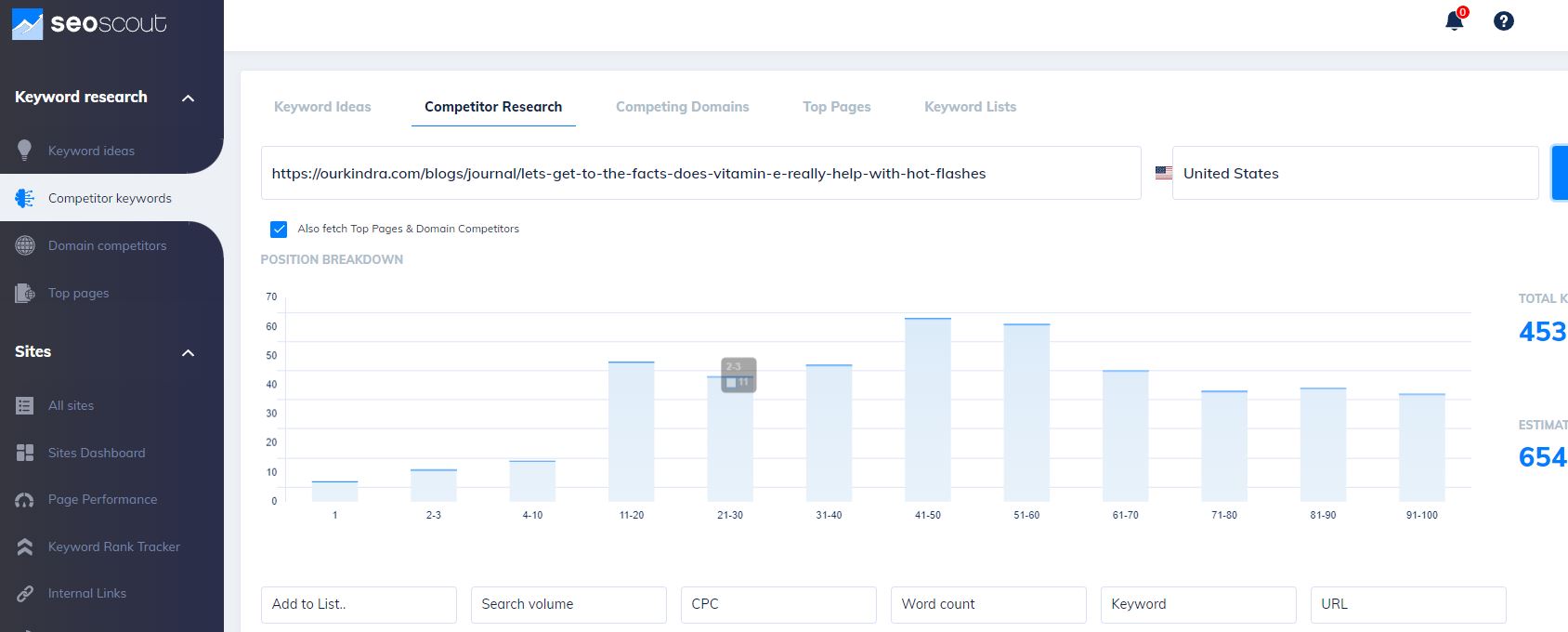
Here are the keyword results.
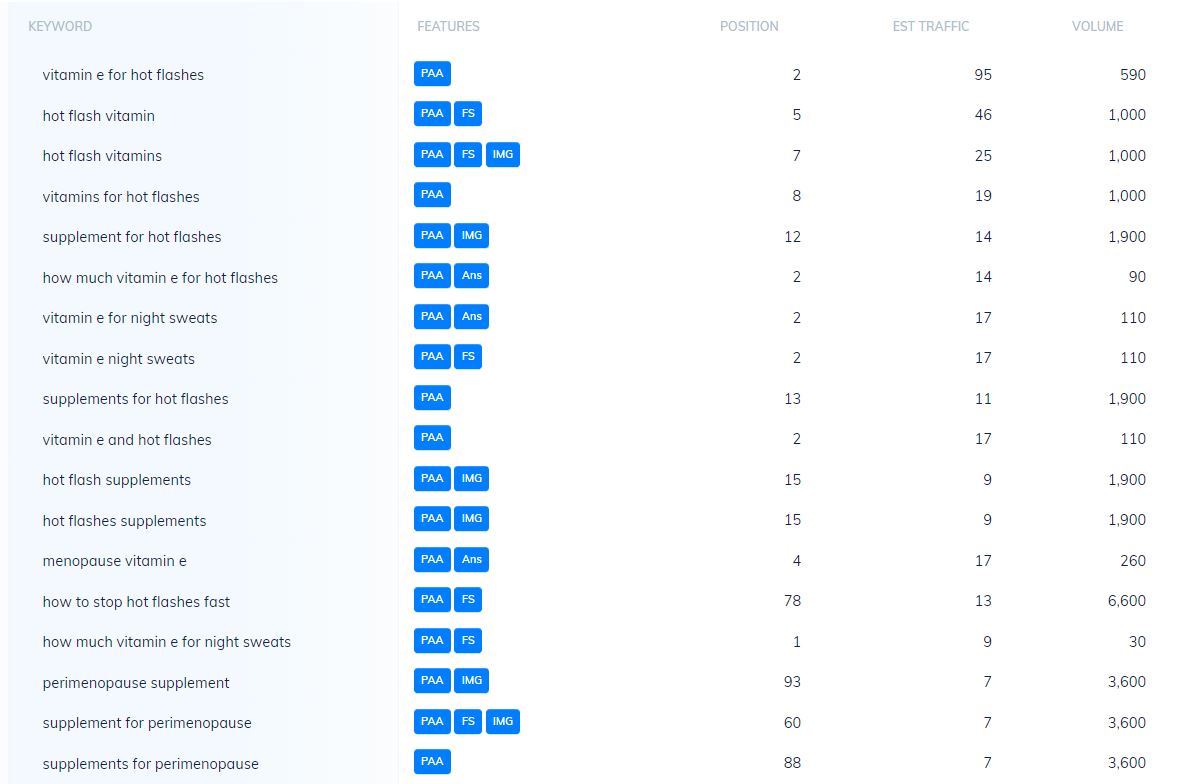
Ahrefs is also a good source for related keywords, but SEO Scout does a better job of offering a variety of keyword options. That doesn’t mean the keywords provided by SEO Scout are a good idea, but it is additional data that helps us know we are making smart decisions – Ahrefs, Moz, and SEMrush are not perfect tools, so using sperate tools to try and validate results is important.
Regardless of how you get keywords, get a lot of them. \
I find that having lots of keywords for the writer helps to keep them on track and write better articles.
With all of my research done, I go into Asana and build the assignment.
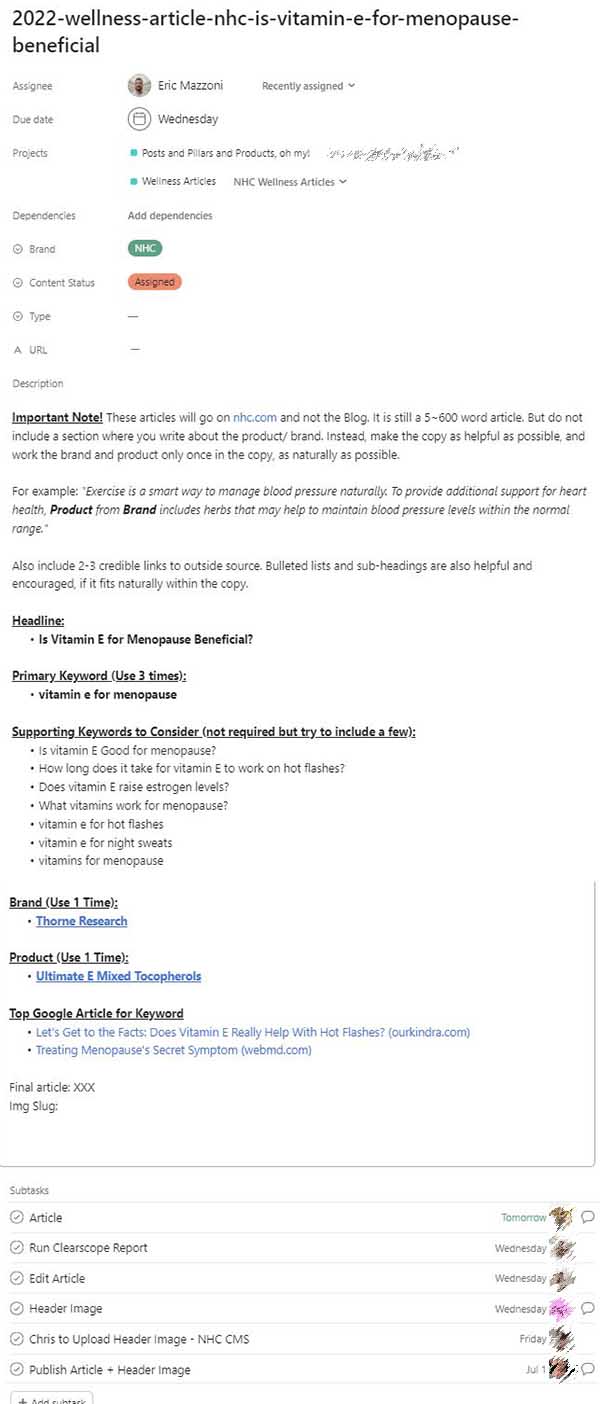
The writers have already been onboarded, so there isn’t too much explanation needed. In rare cases, the topic is more specific and requires a few notes. But, here, that isn’t the case.
This Process is Scalable
The benefit of using Ahrefs and knowing who your competitors are is that you can generate ideas quickly with data to back up your decisions. I can generate more than 100 ideas in a few days with all sorts of variables being considered thanks to Ahrefs.
This is not to say the process is perfect.
Ahrefs can only tell us its interpretation of the data it is gathering. I have been in situations where a keyword looks incredible, but a month later when I go to double check something, the keyword is shown as having no volume.
This has happened with products and brands we want to target as well. We also have tested Ahrefs against MOZ and found that the tools aren’t always aligned on their results either.
It could be that trends changes and what people buy one month isn’t what they buy next more. The same could be said for keywords.
But the swings are sometimes quite significant that I suspect the tools are simply flawed.
Benefits of a Content Calendar
Building a content calendar is an essential part of any content strategy.
What should your content calendar be used for? Your business and goals will dictate that. So before proceeding, you should know what your goals are.
If you aren’t sure about your goals, consider one or more of the following:
- Improving search visibility.
- Gaining newsletter subscribers.
- Increasing sales of a product or service.
- Brand recognition among a larger demographic of people.
- Better serving your internal staff or external partners with announcements.
The practical application of your content calendar will vary based on your goals and the type of business or industry you serve.
For example, if you are creating content for internal staff or external partners, your content calendar may simply highlight company priorities, accomplishments, announcements, and related activities.
For an editorial site, the purpose of your content calendar may be to fill content gaps by targeting keywords that your competitor already ranks for while building authority in a specific niche.
If you operate a news channel, then the content calendar will need to reflect breaking news in the region you cover or within your industry. If there is sponsored content that needs to be written, you will build your calendar around those details.
For an ecommerce site, your content calendar may revolve around new brands or products, optimizing those pages with specific content, and coming up with supporting article ideas to gain internal links to those pages.
Where and how you build your content calendar is up to you. If the number of tasks for your content calendar is small, then a project management tool like Trello, Monday, or Asana may be perfect. Just make sure one person is dedicated to building the task and assigning it out with due dates and any other dependencies or task requirements.
When Things Go Wrong
As I have outlined, not everyone’s content calendar will be the same.
The more moving pieces that are involved the more chances of mistakes being made.
So on one hand, a content calendar is a useful tool that makes assigning and tracking tasks a breeze. On the other, it can be a monster that gets out of hand quickly.
Will you encounter these same challenges? I doubt it. Few other businesses that would benefit form using a content calendar, or already use one, have the complexity as our company. If you are looking to scale your content, then you should think about creating processes that work for you.



